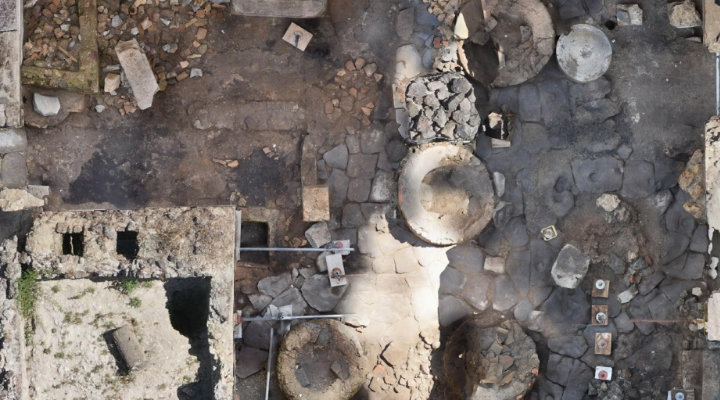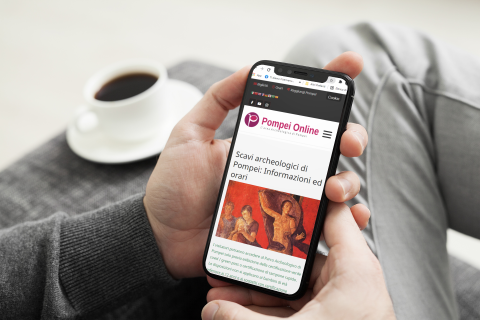
A bakery-prison, where enslaved workers and donkeys were confined and exploited to grind the grain needed to make bread. A cramped room with no view of the outside world and with small windows high in the wall with iron bars to let the light in. In the floor indentations to coordinate the movement of the animals, forced to walk around for hours, blindfolded.
The workspace has emerged in Region IX, Insula 10, where excavations are underway as part of a larger project to secure and consolidate the slopes that form the edge of the unexcavated areas of the ancient city of Pompeii.
Excavations have uncovered a house in the process of renovation. As is often the case, the house is divided into a residential area, decorated with exquisite Fourth Style frescoes, and a productive quarter, in this case a bakery. In one of the rooms of the bakery, three victims were discovered in recent months, confirming that, despite the ongoing renovation, the property was far from uninhabited.
A witness to the backbreaking labour to which men, women and animals were subjected in the ancient mills and bakeries, was the second century AD writer, Apuleius, whose account we are fortunate to have in Metamorphoses IX 11-13. Evidently based on direct knowledge of similar contexts, Apuleus recounts the experience of the protagonist, Lucius, who was transformed into a donkey and sold to a miller.
The new discoveries also make it possible to understand better the practical workings of the premises, which, although not in use at the time of the eruption, gives us a timely confirmation of the disconcerting picture painted by Apuleius.
The production area that has been uncovered is devoid of doors and communication with the outside world; the only exit leads into the atrium of the house, not even the stable has direct access to the street, as is often the case. "It is, in other words, a space in which we have to imagine the presence of people of servile status whose freedom of movement the owner felt the need to restrict," notes Director Gabriel Zuchtriegel, in a co-authored scholarly article published today in the E-Journal of the Pompeii excavations http://pompeiisites.org/e-journal-degli-scavi-di-pompei/. "It is the most shocking side of ancient slavery, the one devoid of both trusting relationships and promises of manumission, where we were reduced to brute violence, an impression that is entirely confirmed by the securing of the few windows with iron bars."
The area of the millstones, located in the southern part of the central room, is adjacent to the stable, characterised by the presence of a long feeding trough.
A series of semicircular indentations can be seen in the volcanic basalt paving slabs around the millstones. Given the robust durability of the material, it is likely that what at first glance might appear to be "footprints" are actually deliberate carvings made to prevent draught animals from slipping on the pavement and simultaneously tracing a path, thus forming a "circular furrow" (curva canalis) as Apuleius also describes it.
"Iconographic and literary sources, particularly the reliefs from the tomb of Eurysaces in Rome, suggest that a millstone was usually moved by a couple consisting of a donkey and a slave. The latter, in addition to pushing the grindstone, had the task of inciting the animal and monitoring the grinding process, adding grain, and collecting the flour."
The wear on the various indentations can be attributed to the endless cycles, always the same, carried out according to the pattern laid out in the pavement. More than just a groove it reminds us of the gears of a clockwork mechanism, designed to synchronize the movement around the four tightly packed millstones found in this area.
The resurfaced space, with its evidence of hard daily life, complements the picture told in the exhibition "The Other Pompeii: Ordinary Lives in the Shadow of Vesuvius"—which will open on December 15 at the Palestra Grande in Pompeii—dedicated to that myriad of individuals often forgotten by the historical sources, such as the slaves, who constituted the majority of the population and whose labour contributed in an important way not only to the economy, but also to the culture and social fabric of Roman civilization.
"In the final analysis," the director adds, "it is spaces like this that also help us understand why there were those who thought it necessary to change that world and why in the same years Paul, a member of a small religious group, who was later canonised, wrote that it is better to be all servants, ‘douloi’, meaning slaves, not of an earthly master, but rather of a heavenly one."
Fonte: Parco Archeologico di Pompei


